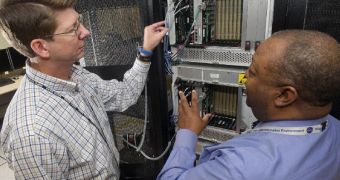The Boeing Company has delivered a new series of software test bed computers to NASA, enabling agency engineers to begin work on developing the flight software for the new Space Launch System (SLS) rocket. The vehicle is scheduled to carry out its maiden flight in 2017.
The American space agency is developing this rocket – the largest since the Saturn V delivery systems that carried the Apollo missions to the Moon – especially for the Orion Multi-Purpose Crew Vehicle (MPCV) space capsule.
Since NASA decided to rely on the private sector in order to deliver astronauts and cargo to low-Earth orbit, it is developing the SLS and Orion for more demanding missions, such as reaching near-Earth asteroids by 2025, and the surface of Mars beyond 2030.
Constructing such a large rocket is not an easy task. The flight software that will control the SLS will be extremely complex, which is why work on it is starting so early on. Each of these rockets will be able to carry 130 metric tons of cargo into space.
“We are moving out very quickly on SLS. SLS will be the most powerful launch vehicle ever built, and it requires the most capable flight software in the history of human spaceflight,” explains Todd May, who manages the SLS program at the NASA Marshall Space Flight Center, in Huntsville, Alabama.
“Having this avionics hardware in place early will allow the NASA SLS team and Boeing to accelerate the flight software development,” he adds. According to May, the new test bed computers will enable engineers to fine-tune the software they've already developed.
When the final SLS flight computer is completed, it will boast the most advanced processing capacity of any avionics computer ever developed. Its design is based on the computers used by the Global Positioning System (GPS) satellites.
NASA programmers will now begin to use the test bed platform to assess the performances of the software they are developing. They have a few years at their disposal before the agency needs their programs, and Boeing delivered the computers ahead of schedule.
The 2017 test flight will see the SLS sending an unmanned MPCV around the Moon. This mission will be followed by another one, in August 2019, when a manned Orion will carry out a similar trip around the Moon.
The next manned exploration missions are scheduled to occur in 2025, 2027, 2029 and 2031.

 14 DAY TRIAL //
14 DAY TRIAL //